Unit-7
Geology of Dam and Reservoir Site
A shape that's constructed throughout a river so that it will shape a reservoir on its upstream facet for impounding water or for storing water is known as dam. A dam includes an impervious or almost impervious membrane, supported towards the thrust of impounded water. In the regular masonry or concrete dam the impervious membrane is a layer of the primary few inches or ft of the upstream facet of the wall, however in different varieties of dams the membrane can be a separate shape, and in earth dams no a part of the shape can be fully impervious, however the float of water is avoided via way of means of frictional resistance to motion supplied via way of means of successive quantities of the embankment. The geology of dam web sites can be taken into consideration below the subsequent heads: Foundations, abutments (leakage), spillways, tunnels (bypass, discharge, etc.) substances for creation. This department is pretty arbitrary, however, due to the fact the elements are so associated that within side the exam of any individual web website online all should be taken into consideration. The price of creation is likewise part of the trouble, and sensible geologic paintings may be executed simplest together with the engineer, in whose look at of the trouble this attention is prominent. The requirements of a reservoir web website online are many and exacting a good basin of sufficient length, a slim outlet requiring a fairly small and cost-effective dam, with foundations capable of preserve the dam, possibility for constructing a secure and sufficient spillway to get rid of surplus water, to be had substances of which to assemble the dam, guarantee that the basin will now no longer fill with dust and sand carried within side the water in too brief a time, sufficient and to be had water deliver etc. Dams are engineering systems built for exceptional purposes. They are of various sizes, shapes and kinds. In all cases, many critical research ought to be completed earlier than finding out the area, kind and length of the dam. Among the ones research is the geological investigations which ought to be completed to infer the geological situations within side the maximum applicable web website online, intensity of the rules and their kinds, cut-off intensity, kind of the to be had creation substances, and kind of the predicted geological dangers. Without right geological investigations, the sitting of a dam will reason critical dangers all through creation and all through commissioning of the dam. Geological research for choosing and finding dam web sites is one of the maximum big research which ought to be completed in exceptional scales and tiers earlier than finding out the quality area for a dam. Therefore, good enough evaluation of web website online geologic and geotechnical situations is one of the maximum big factors of a dam protection evaluation. Evaluation of the protection of a brand new dam requires, amongst different things, that its web website online, abutments, basis and reservoir were thoroughly examined, explored, and investigated in order that the geological situations are absolutely understood as a good deal as feasible.
Various kind of dam are categorized in accordance their purpose, material,
size, hydraulic layout and structural action .
2. Masonry dam
3. Timber dam
4. Steel dam
5. Earth dam
6. Rock fill dam
7. Composite dam
5. Steel dam
6. Cantilever kind metallic dam
7. Direct strutted metallic dam
The call suggests, this dam is built to keep the water at some point of the wet season while there may be a massive float of water. Storage dams keep water for hydroelectric electricity generation, irrigation or flood manipulate venture or can be used for stepped forward habitat for fish and wildlife.

Fig.7.1 Storage dam
2. Coffer dam:
A coffer dam is a transient dam built to ease construction. It’s an enclosure built across the web page to exclude the water in order that the development is performed in dry condition. This is normally constructed at the upstream of the primary dam to divert water right into a channel or diversion tunnel at some point of the development of the dam. When the go with the drift of water is low within side the river, web page is enclosed through coffer dam and the water is pumped out and made dry.
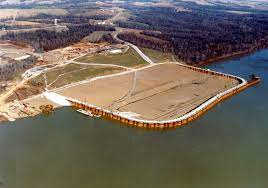
Fig. 7.2 Coffer dam
3. Debris dam:
The dam built to preserve the particles from the river is known as a particles dam. This dam holds off the particles like sand, gravel and flow wooden flowing within side the river with water. When the river passes the particles dam, the water is rather clear.
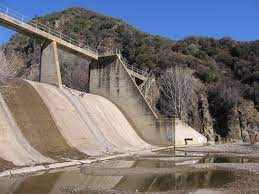
Fig. 7.3 Debris dam
4. Diversion dam:
When there's a want for diverting the water of the river in to a conduit or an off-taking canal, the diversion dam is constructed. These dams offer enough stress for pushing the water into diverse structures like ditches, canals etc. These dams may be used for irrigation and additionally for diverting water from a circulate in to a far off reservoir for garage. These are type of garage weirs which divert water and feature a small garage reservoir on upstream. Sometimes those also are termed as weirs.
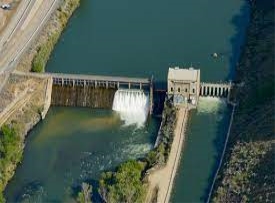
Fig.7.4 Diversion dam
5. Detention dams:
These are the dams that are built to attend to the floods. When there's flood, the detention dam shops a few flood waters and detain the glide of the river at the downstream side. Thus, the impact of the unexpected floods is reduced. The water that is saved within side the dam is then launched steadily at a managed charge relying at the wearing ability of the channel downstream in order that the place of downstream of dam is covered from flood.

Fig.7.5 Detention dam
Concrete dam are gravity dams typically constructed in massive blocks divided via way of means of joints to make the development handier and decrease thermal stress. The joints are grouted after the dam is cooled. Transverse joints are perpendicular to the dam axis. A concrete dam is a major creation mission that desires a big quantity of concrete, ensuing within side the use of a massive quantity of cement. Cement manufacturing is inflicting CO2 emissions which are unfavorable to the surroundings and is likewise a high-fee procedure. Concrete dam are sorts 1) concrete gravity dam 2) concrete buttress dam
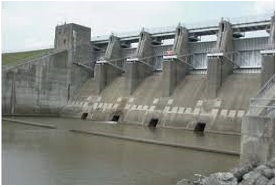
Fig.7.6 Concrete dam
2. Masonry dam:
Masonry dams are dams constituted of masonry– particularly stone and brick, now and again joined with mortar.
They are both the gravity or the arch-gravity type. The biggest masonry dam within side the World is Nagarjuna sagar, Andhra Pradesh & Telangana in India.

Fig.7.7 Masonry dam
3. Timber dam:
A dam whose principal load-sporting structural factors are made from wood, broadly speaking coniferous sorts along with pine and fir.
Timber dams are made for small heads (2-four m or, rarely, four-eight m) and generally have sluices; in step with the layout of the apron they are divided into pile, crib, pile- crib, and buttressed dams.
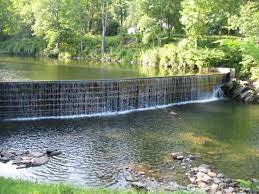
Fig.7.8 Timber dam
4. Steel dam:
A metal dam is a form of dam (a shape to impound or retard the waft of water) this is manufactured from metal, instead of greater not unusual place masonry, earthworks, concrete or wooden production materials.
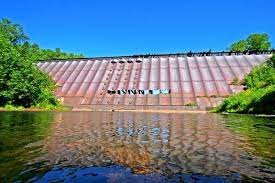
Fig.7.9 Steel dam
5. Earth dam:
Earth dam constructed up via way of means of compacting successive layers of earth, the usage of the maximum impervious substances to shape middle and putting more permeable materials at the upstream and downstream sides.
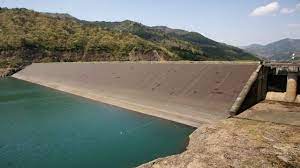
Fig.7.10 Earth dam
6. Rock fill dam:
Rock fill dams are in particular crafted from dumped and compacted rock fill. Rock fill dams are permeable. They have an impermeable center or an impermeable layer at the upstream face of the dam to save you seepage via the porous center. The impermeable components are typically made of bolstered concrete, asphaltic concrete or clay.
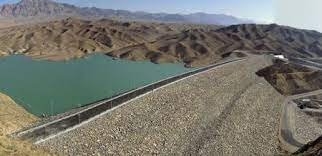
Fig.7.11 Rock fill dam
7. Composite dam:
Composite dams are aggregate of concrete and embankment dams. Construction substances of composite dams are the identical used for concrete and embankment dams.
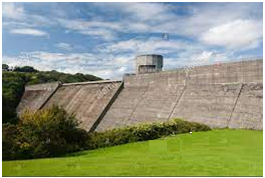
Fig.7.12 Composite dam
A dam designed for elevating the water degree of rivers or for developing a reservoir; it lets in the overflow of water in the course of the passage of excess (flash-flood) discharges over complete duration of the dam crest or via drain openings.
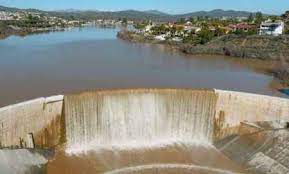
Fig.7.13 Overflow dam
2. Non-overflow dam:
A dam which does not all on the surplus water to overflow over it is crest. But in general spillway is provided for any type dam to release the excess Water from upstream side.
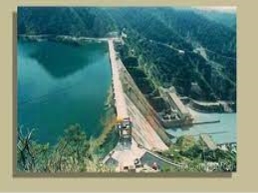
Fig.7.14 Non overflow dam
A Gravity dam is a shape which resists the outside forces through its very own weight or self-weight. Gravity dams are typically built through using masonry or concrete. Various outside forces like water strain, uplift strain, wave strain, ice strain, earth quake strain etc. are resisted through its self-weight simplest which acts vertically downwards. So, true basis is needed to assemble gravity dam ideally rocky strata below the dam.
The form of go segment of gravity dam is about triangular in form. Infiltration gallery may be supplied inside the dam to face up to uplift strain.
The failure of gravity dam can also additionally happens because of sliding, overturning or crushing at toe. Hence, better thing of protection is usually recommended for the layout of gravity dam.
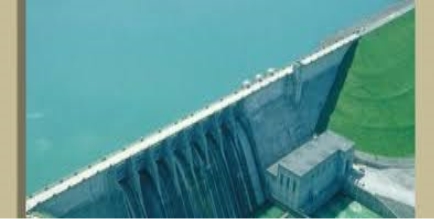
Fig.7.15 Gravity dam
2. Earth dam:
Earthen dams are product of normal soil that is affordably available. This form of dams is appropriate wherein the inspiration soil may be very susceptible and now no longer sturdy sufficient to hold the burden of masonry dam. Since its miles built the use of soil the price of creation may be very much less as compared to inflexible kind dam.

Fig.7.16 Earth dam
3. Rock fill dam:
The dam made in rock fragments and huge length boulders with an impervious membrane located at the rock fill on its upstream aspect is known as rock fill dam. Impervious membrane lessen the seepage through the dam.
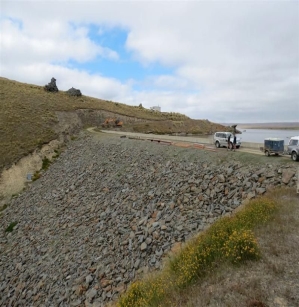
Fig.7.17 Rock fill dam
4. Timber dam:
Timber dams generally used for temporary purposes such as to divert the water for the construction of main dam, to control flood water flow etc. Timber dams are suitable up to 9 meters height.
-In timber dam there are three types:
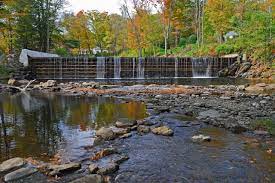
Fig.7.18 Timber dam
5. Steel dam:
Steel dams also are used for transient necessities like wood dams. Steel plates and willing struts are used for the development of metal dam.
This kind of dams are appropriate up to fifteen to 18 meters of height.
- Steel dam are categorized into two types:
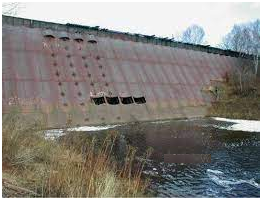
Fig.7.19 Steel dam
-Depending up on structure and design dams are classified into
1. Gravity Dam:
A Gravity dam is a shape which resists the outside forces through its very own weight or self-weight. Gravity dams are usually built through using masonry or concrete. Various outside forces like water stress, uplift stress, wave stress, ice stress, earth quake stress etc. are resisted through its self-weight handiest which acts vertically downwards. So, precise basis is needed to assemble gravity dam ideally rocky strata be neat the dam.
The form of go phase of gravity dam is about triangular in form. Infiltration gallery may be furnished in the dam to withstand uplift stress.
The failure of gravity dam may also happen because of sliding, overturning or crushing at toe. Hence, better thing of protection is suggested for the layout of gravity dam.
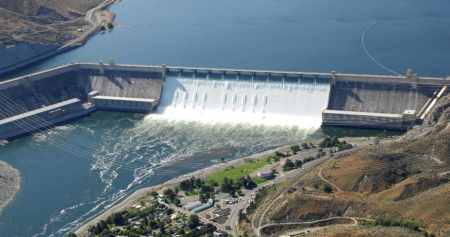
Fig.7.20 Grand Coulee Gravity Dam, USA
2. Arch Dam:
An arch dam is curved in plan with its convex upstream. Various forces coming onto the dam are resisted through its arch action. It is built using masonry or concrete however calls for much less fabric in comparison to gravity dam. The masses coming onto the dam are transferred to the abutments of dam. So, abutments should be more potent and usually herbal formations like hills are used as abutments. Arch dams are usually desired for slim valleys.
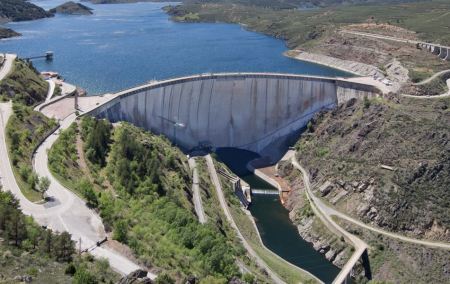
Fig.7.21 Arch dam
3. Buttress Dam
A buttress dam incorporates face slab, buttresses and base slab. Face slab is supplied at the upstream aspect with a few inclinations and this slab is supported via way of means of collection of buttresses that are not anything however supports. Base slab acts as basis for the entire dam which gets the weight from buttresses and face slab. Buttress dam is both directly or curved in plan.

Fig.7.22 Buttress dam
4. Embankment Dam:
Embankment dam is made from soil or rocks. This sort of dams are come be neat non inflexible kind dams. Embankment dams are once more categorized into 3 exclusive types Homogeneous embankment kind dam-
a) Zoned embankment dam
b) Diaphragm embankment dam
c) Homogeneous embankment dam
If the dam is built the usage of best one sort of soil, then its miles known as homogeneous embankment kind dam. But homogeneity of soil makes the dam pervious and permit seepage of water via the dam. To triumph over this stone pitching is usually recommended at the upstream side.
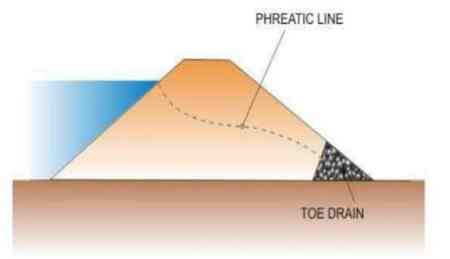
Fig.7.23 Embankment dam
a) Zoned embankment type dam:
Zoned embankment dam consists an impervious soil zone in side the pervious soil layer. Clay or silt or mixture of clay and silt is used to make the impervious zone. Ordinary soil is used for make the previous outer layer.
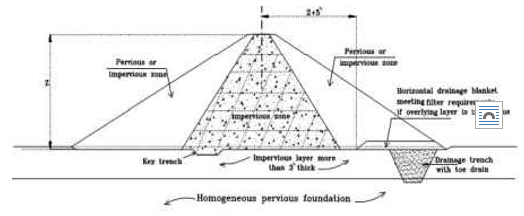
Fig.7.24. Zoned embankment dam
b) Diaphragm embankment dam:
Diaphragm embankment dam consist a diaphragm min. side the earthen dam and it is made of impervious soils or concrete or steel or timber.
This diaphragm prevents the seepage of water through dam section.
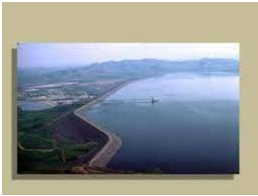
Fig.7.25 Diaphragm embankment dam
It is used for city water supply, irrigation water supply and a hydroelectric project.
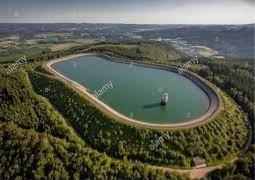
Fig.7.26 Storage reservoir
2. Flood-control reservoir:
A flood manage reservoir commonly known as flood mitigation reservoir which shops a part of the flood flows which similarly limit the flood peaks and for this reason defend the downstream areas.
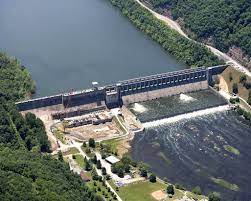
Fig.7.27 Flood control reservoir
3. Multi-purpose reservoir:
This type of reservoir is planned and constructed to serve various purposes all together.
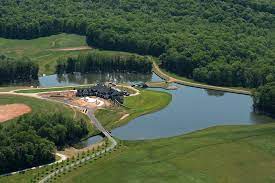
Fig.7.28 Multipurpose reservoir
Required geological consideration for selecting of dam
1) Topographical scenario of the dam:
One of the essential elements within side the choice of the dam web website online is the valley form. The valley sorts represent an essential criterion for determining the kinds of dams to be constructed on them the valley in beginning the geological gadgets of properties, valley opens aspect (glacial, river) valley, height, the circulation float device. Varies relying at the grooves in level of the valley shaped phase. According to the form and width of the valley, a few dam sorts aren't taken into consideration at all. For instance, concrete arch dam isn't always made on a extensive valley.
-It is taken into consideration to assemble gravity or arch type.
-dam if the valley consists solar folded, non-damaged rocks.
-Valley Types
1. Narrow V type
2. Wide V type
3. Narrow type
4. Wide U type
2) Foundation and geological structure:
The basis situation of the dam web website online isn't always appropriate for every dam type.
3) Location and sort of appropriate fabric for use in dam construction:
There are 3 kinds of herbal substances required for dam creation. These are mixture for rock, concrete for soil, filler and riprap for filling.
4) Transportation facilities:
If the dam web website online is near present roads, which reduces the fee of latest street creation. Access to the fabric quarries is likewise essential whilst choosing the dam.
5) Translate (derivation) situations:
In order with the intention to assemble the dam be neat dry situations, the upstream and downstream facets of the development web website online need to be appropriate to be closed with low dams referred to as altitude.
6) Full spillway capability and location:
A spillway is positioned on the pinnacle of the reservoir pool. Dams may additionally have backside shops with valves or gates which can be operated to launch flood float, and some dams lack overflow spillways and depend completely on backside shops.
7) Earthquake zone:
Dams are frequently constructed in energetic earthquake regions. Reservoirs can cause earthquakes. Some water delivers systems are liable to earthquake motion. Embankments and outlet towers reply to earthquake vibrations. Shaking an risky slope that has been weakened after saturation with the aid of using rises in floor water tiers might also additionally produce a landslide into the reservoir. The outcome of a dam or water deliver failure is excessive. The consequences of a dam failure on human beings and systems downstream are dramatic and obvious. A much more likely instance of earthquake harm could be lack of manage the water deliver.
8) Climatic situations and length of creation:
In Dam the moist season is hot, oppressive, and overcast and the dry season is warm, humid, and in the main clear. Over the direction of the year, the temperature commonly varies from fifty 6°F to 96°F and is hardly ever be neat 51°F or above 101°F. An opportunity technique is to unfold a concrete blend and compact it down the usage of rollers. The dam is raised in steps of round six hundred mm at a time.
9) Landslide:
Large waves may be made out of floor slopes of the dam to the landslide and the lake.
10) Economic scenario of the country:
Dams always fee greater and take longer to construct than projected. In general, the bigger a hydro challenge is, the bigger its creation fee overrun in percent terms. The World Commission on Dams determined that on common, massive dams had been at first-class best marginally economically viable. The common fee overrun of dams is fifty six%. This method that after a dam is expected to fee $1 billion, it finally ends up costing $1.fifty six billion.
Required geological situation for selecting reservoir:
1) Catchment place need to have such geological situations that percolation and absorption losses are minimum.
2) Available run-off need to be maximum.
3) The need to be unfastened from fissured rocks.
4) This will keep away from opportunities of leakage whilst reservoir is complete to capability.
5) The reservoir web website online ought to have ok capability.
6) The reservoir basin need to have a deep slim beginning within side the valley in order that the period of the dam can be stored minimum.
7) Heavily silt encumbered tributaries need to no longer lead their discharge to the reservoir.
8) Suitable site for dam should be available.
9) It may be a really perfect if dam is built on the slim and shallow a part of the river which lies down circulation of the deep river.
10) It may be very essential factor as fee of dam is usually a controlling aspect in choice of the reservoir’s web website online.
11) Site need to be such that deep reservoir is shaped.
12) Deep reservoir could save greater of water and disclose minimal place on the floor for evaporation.
13) If earthen dam is suggesting to be assemble, then separate appropriate web website online for spillway works need to be to be had.
14) Reservoir web website online need to be nicely linked with the aid of using rail and street.
15) Materials for the development of dam need to be to be had nearby.
16) The soil formation at reservoir web website online need to be unfastened from dangerous salts.
17) If reservoir water is to be use for irrigation, the dam web website online need to be close to the place, suggest to be irrigate.
18) This could lessen the period of the canal device and therefore the fee of the challenge.
19) Reservoir need to know no longer submerge habited place or regions of fertile lands or gardens.
20) River banks need to be hard, robust and excessive in order that fee on river schooling works is minimum.
1) Overtopping: These disasters arise because of bad spillway layout, main to a reservoir filling too excessive with water, especially in instances of heavy rainfall. Other reasons of this form of failure consist of settling of the crest of the dam or spillway blockage.
2) Foundation defects: These disasters arise because of settling within side the basis of the dam, instability of slopes surrounding the dam, uplift pressures, and seepage round the muse.
3) All of those disasters bring about structural instability and capacity dam failure.
4) Piping and seepage disasters: These disasters arise because of inner erosion due to seepage and erosion alongside hydraulic systems including the spillways. As well, erosion because of animal burrows and cracks within side the dam shape makes contributions to those disasters.
5) Conduit and valve failure: These disasters arise because of issues with values and conduits.
6) Other dam disasters stand up because of different miscellaneous reasons. Many dam disasters also are secondary outcomes of different herbal failures including earthquakes, landslides, intense storms, or heavy snow-melt. Other reasons consist of device malfunction, structural damage, and sabotage.
a) Horizontal beds
b) Beds dipping downstream
The nature of rock on reservoir may be very vital. The water saved within side the reservoir percolates will it reaches the containing (impervious) layer. The confining mattress is important for garage of water. Massive horizontally bedded lime stones, extraordinarily loose from solution.
2. Bed dipping upstream:
Bed at reservoir, if dipping upstream can saved water effectively. For the suitability of the dam, beds dipping upstream are maximum appropriate vicinity for production. Through basis of the dam is desired on unmarried uniform mattress rock.
3. V shaped and U-shaped valley:
Deep reservoir and huge garage ability may be obtained in valley are appropriate vicinity for storing the water. Large amount of evaporation loss may be avoided.
4. High drainage density:
High drainage density is appropriate for reservoir, as large amount of water enter may be feasible reservoir. Drainage within side the surrounding vicinity performs a important position or addition of water in reservoir.
5. Unfavorable dips:
a) Horizontal beds: The dam built on horizontal beds are strong in comparison to the dam on dipping beds. If the underlying rock are hard, impervious, dams can face up to for an extended duration and water may be saved.
b) Beds dipping downstream: The balance of the dam at the rocks on which the dam is founded. If dam basis is built on unmarried uniform rock then it's miles relatively greater strong them the dam of basis on a couple of layer.
1) Actions including the use of sandbags to boom freeboard and save you overtopping, the use of riprap to save you erosion to the dam shape, or making use of a geo-fabric clear out cloth to fight piping are all examples of emergency intervention strategies that may be used to attempt to keep a dam from a complete failure.
2) Selection of Dam
3) Estimation of the PMF and choice of the IDF
4) Identification of earthquake supply vicinity and shape, estimation of MCEs, and identity of earthquake-associated protection concerns
5) Development of a unique geo-technical, Exploration program
6) Design of the foundation, dam, and appurtenant systems
7) Design of a device of instrumentation to screen the overall performance of the dam, basis, and appurtenant systems
8) Development of a preliminary reservoir-filling and surveillance plan and of reservoir drawdown standards
9) Preparation of designers running standards and identity of unique issues to be discovered at some stage in production and operation
10) Provisions for the automatic, unbiased overview with the aid of using Sable people of all layout decisions, strategies, procedures, and outcomes associated with dam protection
11) Provisions to revise the layout to make it well matched with situations encountered at some stage in production
Significance:
1) Modeling the muse rock discontinuities constitute the sector situations within side the evaluation greater realistically.
2) It is virtually indicated from examine that the Interaction among dam monoliths and discontinuities within side the basis rock mass offer sensible dam reaction.
3) The homes of discontinuities of rock hundreds within side the vicinity of huge venture including dam production have a remarkable affect on their engineering conduct.
4) Foundation on which dam rests, has foremost affect at the conduct of the dam.
5) As has been learnt from beyond dam disasters approximately the position of basis mass, it's miles vital to examine the reaction of dam resting on basis rock mass comprising of discontinuities.
6) Foundation geological situations virtually demarcate the discontinuities within side the basis place below examine.
7) For information the impact of basis discontinuities, version with dam discontinuities and basis discontinuities has been taken into account.
Treatments:
1) The remedy strategies of the vulnerable rock hundreds and discontinuities are cautiously decided along with the concrete cushion, concrete alternative grids, and consolidation grouting.
2) They paintings collectively to beautify the power and integrity of the dam basis.
3) Excavation layout of abutments: The slopes within side the proper financial institution are especially composed of marble that has incredibly right mechanical property. The stages of weathering and unloading intensity of the marble formation are essentially in a regular range, and the unloading intensity is commonly much less than 50m. The rocks within side the intensity under 50m are nearly clean and categorized into grade II or III, a right preference for host rocks of the dam basis. In this way, the scope of slope excavation is confined in the boundaries of the weathered and unloading belts within side the proper abutment.
4) Design schemes of concrete cushion gadget for susceptible rocks within side the basis surface: The concrete cushion within side the left abutment is built within side the elevations of 1730–1885m. The thickness of the concrete cushion at unique elevations is needed consistent with the arch dam form and the excavation scope of the spandrel groove.
5) Treatment layout of consolidation grouting for susceptible rock hundreds of the resistance blocks in left dam basis: The resistance blocks within side the left dam basis essentially includes intensively unloaded rock hundreds of grades III2 and IV. Thus, powerful remedy with consolidation grouting wishes to be taken into consideration for the cause of stability.
References:
1. Engineering and General Geology, Parbin Singh, 8th Edition (2010), S K Kataria & Sons.
2. Text Book of Engineering Geology, N. Chenna Kesavulu, 2nd Edition (2009), Macmillan Publishers India.